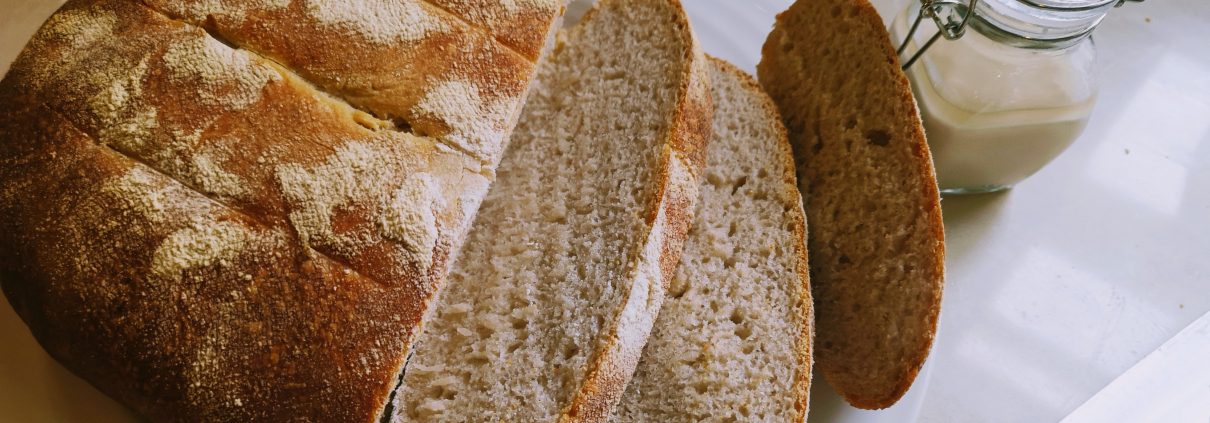Warning: Making Sourdough Bread is a labour of love, but like anything we do for love it is always worthwhile.
This loaf took about 4 days from start to finish. It was my first attempt and I was pleased with the result.
I admit that I cheated a little and bought at sourdough starter from ‘Baz and Ed’s Street Food’ at a food fair in Enniskillen. However, if you are very dedicated you can make your own starter…. I have dug out a recipe from the Doyenne of Irish cooking: Darina Allen; I haven’t tried it, but I’m sure it’s the business.
Once you have the starter there isn’t a whole lot of work, but there is a whole lot of waiting. However, the starter can be reused over and over again so once you’ve started on your journey of sourdough bread making you may be in for the long haul.
SOURDOUGH STARTER
(Made 24-48 hours in advance … the longer the better)
7g (1/2 oz) fresh yeast (one packet dried yeast)
50ml (2fl oz) body temperature water
340ml (12fl oz) warm water
500g (1lb plain white flour)
Make the starter by stirring the yeast with the 50 ml of water until creamy and allow to stand for 10 minutes.
Stir in the remaining water and flour 125g (5oz) at a time.
Move to a lightly oiled bowl and cover with cling film or a tea towel.
Allow to rise at room temperature for 24-48 hours, or longer. It will triple in volume but will be liquid and sticky.
Pour into a sterilized jar and refrigerate until needed.
HOW TO MAKE SOURDOUGH BREAD
Once you have your starter, take out 300g for making the sourdough bread and set the other 200g of starter aside for making another batch.
Ingredients:
500g (1lb) strong bread flour
1 teaspoon fine salt
300g (10.5 oz) sourdough starter
225 ml (7.5 fl oz) warm water.
Method:
- Mix the flour, salt, starter and water in a bowl until combined (you can use an electric mixer with dough hook attachment if you have one).
- Tip the dough onto a floured surface and knead for 10 minutes until soft and elastic (it should be stretchy). Alternatively, use an electric mixer on medium-high speed to do the hard work for you.
- Place the dough in a large, lightly oiled bowl and cover. Leave in a warm place (like an airing cupboard) for 3 hours to prove.
- After 3 hours, remove the dough and punch out the air (it may have only risen a little, that’s normal for sourdough as it takes a long time to prove).
- Now tip out the dough and give it another quick knead, then place it in a large bowl lined with a tea towel and floured, you want the seem facing upwards.
- Cover the bowl and return to prove in its warm place for a further 4-8 hours. (Or a cooler place, overnight). The dough is ready when it has doubled in size.
- Preheat the oven to 210C, 410F, Gas 8. Place a large baking tray in the oven to heat up and a small baking tin filled with water at the bottom of the oven to create some steam.
- Remove the hot baking try and sprinkle with the flour. Tip the risen dough very gently onto the try (you don’t want to knock out the air bubbles).
- Slash the top a few times and bake for 30-40 minutes until golden. You can tell if it is done by giving the loaf a tap on the bottom – it should sound hollow.
Leave to rest for a few minutes before serving.
Sourdough bread can be a bit hard the next day; perk it up by popping in the toaster, or by making French toast or croutons.
To use the sourdough starter simply ‘feed’ 100g of starter with 50g flour and 50ml of warm water three times over a 48h period. This It will give 400g of starter: 300g for the next loaf and 100g of starter set aside for next time. The starter will keep in the fridge for a week and can be reused indefinitely so long as you keep making the bread….
I warned you this was a labour of love but it is hard to beat the smell and taste of homemade bread.
Best of luck!










